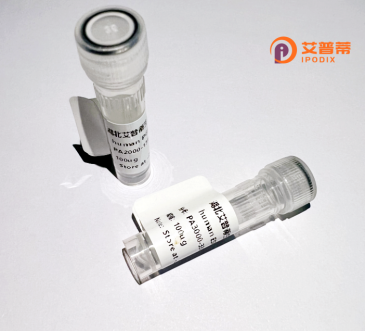
| 纯度 | >90%SDS-PAGE. |
| 种属 | Human |
| 靶点 | XPOT |
| Uniprot No | O43592 |
| 内毒素 | < 0.01EU/μg |
| 表达宿主 | E.coli |
| 表达区间 | 1-962 aa |
| 活性数据 | MDEQALLGLNPNADSDFRQRALAYFEQLKISPDAWQVCAEALAQRTYSDDHVKFFCFQVLEHQVKYKYSELTTVQQQLIRETLISWLQAQMLNPQPEKTFIRNKAAQVFALLFVTEYLTKWPKFFFDILSVVDLNPRGVDLYLRILMAIDSELVDRDVVHTSEEARRNTLIKDTMREQCIPNLVESWYQILQNYQFTNSEVTCQCLEVVGAYVSWIDLSLIANDRFINMLLGHMSIEVLREEACDCLFEVVNKGMDPVDKMKLVESLCQVLQSAGFFSIDQEEDVDFLARFSKLVNGMGQSLIVSWSKLIKNGDIKNAQEALQAIETKVALMLQLLIHEDDDISSNIIGFCYDYLHILKQLTVLSDQQKANVEAIMLAVMKKLTYDEEYNFENEGEDEAMFVEYRKQLKLLLDRLAQVSPELLLASVRRVFSSTLQNWQTTRFMEVEVAIRLLYMLAEALPVSHGAHFSGDVSKASALQDMMRTLVTSGVSSYQHTSVTLEFFETVVRYEKFFTVEPQHIPCVLMAFLDHRGLRHSSAKVRSRTAYLFSRFVKSLNKQMNPFIEDILNRIQDLLELSPPENGHQSLLSSDDQLFIYETAGVLIVNSEYPAERKQALMRNLLTPLMEKFKILLEKLMLAQDEERQASLADCLNHAVGFASRTSKAFSNKQTVKQCGCSEVYLDCLQTFLPALSCPLQKDILRSGVRTFLHRMIICLEEEVLPFIPSASEHMLKDCEAKDLQEFIPLINQITAKFKIQVSPFLQQMFMPLLHAIFEVLLRPAEENDQSAALEKQMLRRSYFAFLQTVTGSGMSEVIANQGAENVERVLVTVIQGAVEYPDPIAQKTCFIILSKLVELWGGKDGPVGFADFVYKHIVPACFLAPLKQTFDLADAQTVLALSECAVTLKTIHLKRGPECVQYLQQEYLPSLQVAPEIIQEFCQALQQPDAKVFKNYLKVFFQRAKP |
| 分子量 | 136.4 kDa |
| 蛋白标签 | GST-tag at N-terminal |
| 缓冲液 | PBS, pH7.4, containing 0.01% SKL, 1mM DTT, 5% Trehalose and Proclin300. |
| 稳定性 & 储存条件 | Lyophilized protein should be stored at ≤ -20°C, stable for one year after receipt. Reconstituted protein solution can be stored at 2-8°C for 2-7 days. Aliquots of reconstituted samples are stable at ≤ -20°C for 3 months. |
| 复溶 | Always centrifuge tubes before opening.Do not mix by vortex or pipetting. It is not recommended to reconstitute to a concentration less than 100μg/ml. Dissolve the lyophilized protein in distilled water. Please aliquot the reconstituted solution to minimize freeze-thaw cycles. |
以下是关于重组人XPOT蛋白的3篇代表性文献摘要信息:
1. **文献名称**:*Exportin-T: A mediator of tRNA nuclear export and cytoplasmic localization*
**作者**:Lund E, Dahlberg JE
**摘要**:该研究通过重组人XPOT蛋白表达,系统分析了其与RanGTP及tRNA的相互作用机制,验证了XPOT在依赖RanGTP的tRNA核质转运中的关键作用,并揭示其底物特异性结合结构域。
2. **文献名称**:*Structural basis for tRNA recognition by exportin-XPO-T/XPOT*
**作者**:Chook YM, Cook A
**摘要**:利用X射线晶体学解析了重组人XPOT蛋白与tRNA及RanGTP的复合物结构,阐明XPOT通过识别tRNA特定茎环构象实现选择性装载的结构基础,提出其“变构门控”转运模型。
3. **文献名称**:*XPOT promotes tRNA nuclear export in mammalian cells*
**作者**:Kutay U, Arts GJ
**摘要**:通过体外重组实验结合细胞敲除模型,证实XPOT蛋白是人细胞中tRNA核输出的必需因子,其活性依赖于与RanGTP的协同作用,并发现XPOT功能缺陷导致细胞翻译异常和生长抑制。
注:实际文献可能存在标题/作者差异,建议通过PubMed/Google Scholar以“XPOT”、“exportin-T”、“tRNA export”为关键词进一步验证。
**Background of Recombinant Human XPOT Protein**
The Exportin-T (XPOT) protein is a key member of the karyopherin-β family, primarily involved in the nuclear export of transfer RNAs (tRNAs). In eukaryotic cells, tRNAs are transcribed in the nucleus and must be transported to the cytoplasm for protein synthesis. XPOT plays a critical role in this process by binding to mature tRNAs in a Ran-GTP-dependent manner, forming export-competent complexes that traverse the nuclear pore. This ensures the timely delivery of tRNAs to the translation machinery, maintaining cellular homeostasis.
Dysregulation of XPOT has been linked to impaired tRNA trafficking, contributing to translational errors, cellular stress, and diseases such as neurodegeneration or cancer. Structural studies reveal that XPOT contains characteristic HEAT repeats, enabling flexible interactions with tRNAs and regulatory factors. To facilitate functional and biomedical research, recombinant human XPOT protein is engineered using heterologous expression systems (e.g., *E. coli* or mammalian cells), often tagged for purification and detection. Its applications span *in vitro* tRNA export assays, structural analysis, and screening for inhibitors targeting export pathways. Recombinant XPOT also aids in studying cross-talk between tRNA trafficking and viral infections, as some pathogens hijack this machinery. Overall, it serves as a vital tool for dissecting tRNA biology and developing therapeutics for related disorders.
×